Heat stress losses top 200 litres of milk a cow, study shows
 © Budimir Jevtic/Adobe Stock
© Budimir Jevtic/Adobe Stock Milk losses can top 200 litres a cow over the summer period without careful management, a study has shown.
The six-month study into the effect of heat stress in dairy cattle was carried out by Tom Chamberlain of consultancy firm Chalcombe and Lallemand Animal Nutrition.
Cattle were observed across eight outdoor and six indoor farms – none of which was equipped with fans or misting systems – to evaluate the effect of heat stress in both housed and grazed herds.
See also: Cattle heat stress ‘more likely’ in future UK climate, study finds
Temperature and humidity were measured indoors and at pasture. The data were then combined to produce a temperature and humidity index (THI) figure for housed cattle and a dairy heat load index (DHLI) number for grazed cattle.
These represent the severity of heat stress (see “Parameters for benchmarking heat stress”).
Results
Across the housed systems, milk yield losses caused by heat stress averaged 128 litres a cow over the summer period – ranging from 84 to 191 litres a cow, explains Dr Chamberlain.
But the greatest losses were seen in grazed herds, averaging 284 litres a cow over the same period. “They [losses] ranged from 171 to 445 litres [a cow], but actual losses would depend on the amount of shade available,” he adds.
In grazed systems, Dr Chamberlain says producers’ final losses resulting from heat stress could amount to more than £20,000 on average for every 200 cows.
In housed systems, this figure is likely to be about £10,000. “These losses equate to the full sales value of the milk, as no costs, such as concentrates fed, could be recovered.”
Monitoring and mitigating stress
Cows start to suffer when the temperature goes higher than 20C, he says.
Farmers can take simple steps to monitor the effects of heat:
- Check if cows are panting: if they reach more than 60 breaths a minute, it suggests they are suffering from heat stress
- Observe cow behaviour: are cows standing more or clustering in the shade?
To help mitigate heat stress, producers should provide cows with as much access to shade as possible and ample cool water, as water intakes rise markedly during heat stress, says Lallemand’s Lientjie Colahan.
Nutrition is also worth reviewing, she says. “When animals are suffering with heat stress their rumen is not working as efficiently as usual.”
In this situation, she adds it might be worth considering supporting the rumen with feed additives.
“Another effect of heat stress is cows suffering from a sodium deficiency,” adds Mrs Colahan. “A side effect of this is reduced feed and water intakes, which can negatively affect mineral balance and milk performance.”
Free access to salt licks around the feeding area should help mitigate this, she says.
Next steps
The study will be replicated and upscaled this year, carrying out trials on 20 sites across 10 farms, over a wider geographical area.
The findings from these sites will be reported in real-time and dairy farmers will be able to view them at https://bit.ly/3sMo25X.
Parameters for benchmarking heat stress |
|||
|
Heat stress level |
Estimated yield loss |
Temperature and humidity index score |
Dairy heat load index score |
|
None |
0 litres/day |
< 62 |
<23 |
|
Moderate |
0-2 litres/day |
62-72 |
23-26 |
|
High |
2-4 litres/day |
73-79 |
37-46 |
|
Severe |
More than 4 litres/day |
>79 |
>46 |
|
Source: Lallemand Animal Nutrition |
|||
